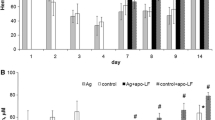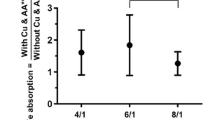Abstract
The ferroxidase activity of ceruloplasmin is often determined according to the method of Johnson et al. (1967), using apotransferrin for trapping ferric ions generated by the enzyme; spectrophotometrically monitoring the Fe–transferrin formation at pH6.0. Reports have shown that ascorbate inhibits this reaction, and it is hypothesized that the effect could be of physiological significance in individuals with a high ascorbate to ceruloplasmin ratio in plasma (e.g. premature babies).
The present study shows that the inhibitory effect of ascorbate rapidly decreases with increasing pH. At pH7.4 no significant effect was observed, the result suggesting that ascorbate is not a physiological inhibitor of ceruloplasmin. Furthermore, experiments demonstrate that at acidic pH the inhibitory effect of ascorbate on the rate of Fe–transferrin formation is not primarily due to an interaction with ceruloplasmin, but to a reduction of enzymically generated ferric ions before they are bound to apotransferrin.
Similar content being viewed by others
References
Baldwin DA, De Sousa DMR, von Wandruszka RMA. 1982 The effect of pH on the kinetics of iron release from human transferrin. Biochim Biophys Acta 719, 140–146.
Carver, FJ, Frieden E. 1978 Factors affecting the adenosine triphosphate induced release of iron from transferrin. Biochemistry 17, 167–172.
Carver FJ, Farb DL, Frieden E. 1982 The effect of albumin, ceruloplasmin, and other serum constituents on Fe(II) oxidation. Biol Trace Element Res 4, 1–19.
Frieden E, Hsieh HS. 1976 Ceruloplasmin: the copper transport protein with essential oxidase activity. Adv Enzymol 44, 187–236.
Gutteridge JMC. 1978 Caeruloplasmin: a plasma protein, enzyme, and antioxidant. Ann Clin Biochem 15, 293–296.
Gutteridge JMC. 1985 Inhibition of the Fenton reaction by the protein caeruloplasmin and other copper complexes. Assessment of ferroxidase and radical scavenging activities. Chem-Biol Interact 56, 113–120.
Gutteridge JMC. 1991 Plasma ascorbate levels and inhibition of the antioxidant activity of caeruloplasmin. Clin Sci 81, 413–417.
Gutteridge JMC, Stocks J. 1981 Caeruloplasmin: physiological and pathological perspectives. CRC Crit Rev Clin Lab Med 14, 257–329.
Gutteridge JMC, Richmond R, Halliwell B. 1980 Oxygen free-radicals and lipid peroxidation: inhibition by the protein caeruloplasmin. FEBS Lett 112, 269–272.
Harris ZL, Takahashi Y, Miyajima H, et al. 1995 Aceruloplasminemia: Molecular characterization of this disorder of iron metabolism. Proc Natl Acad Sci 92, 2539–2543.
Johnson DA, Osaki S, Frieden E. 1967 A micromethod for the determination of ferroxidase (ceruloplasmin) in human serums. Clin Chem 13, 142–150.
Løvstad RA. 1974 Interaction of phenothiazine derivatives with human ceruloplasmin. Biochem Pharmacol 23, 1045–1052.
Morgan EH. 1979 Studies on the mechanism of iron release from transferrin. Biochim Biophys Acta 580, 312–326.
Osaki S. 1966 Kinetic studies of ferrous ion oxidation with crystalline human ferroxidase (ceruloplasmin). J Biol Chem 241, 5053–5059.
Osaki S, Johnson DA, Frieden E. 1966 The possible significance of the ferrous oxidase activity of ceruloplasmin in normal human serum. J Biol Chem 241, 2746–2751.
Powers HJ, Loban A, Silvers K, Gibson AT. 1995 Vitamin C at concentrations observed in premature babies inhibits the ferroxidase activity of caeruloplasmin. Free Rad Res 22, 57–65.
Princiotto JV, Zapolski EJ. 1975 Difference between the two iron-binding sites of transferrin. Nature 255, 87–88.
Author information
Authors and Affiliations
Rights and permissions
About this article
Cite this article
L¿vstad, R.A. A study on ascorbate inhibition of ceruloplasmin ferroxidase activity. Biometals 10, 123–126 (1997). https://doi.org/10.1023/A:1018383207608
Issue Date:
DOI: https://doi.org/10.1023/A:1018383207608




